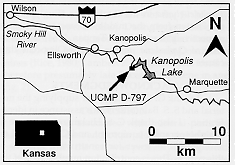PaleoBios, Volume 17, Number 1, Pages 20-26, July 13, 1996
Bacteria and protists from Middle Cretaceous amber of Ellsworth
County, Kansas
Benjamin M. Waggoner
Department of Integrative Biology, University of California, Berkeley, CA 94720
ABSTRACT
Microfossils of sheathed bacteria and amoebae are reported from the middle Cretaceous amber of
Ellsworth County, Kansas. The sheathed bacteria are morphologically very close to the living genus
Leptothrix. Testate amoebae resemble the modern genera
Pontigulasia and Nebela; these are the oldest fossil representatives
of these genera. Other microfossils represent unicellular protists of some sort but cannot be identified further.
This microfossil assemblage, similar to that in late Triassic amber from Bavaria, probably indicates an
aquatic, oligo-mesosaprobic paleomicrohabitat. It also provides direct confirmation of morphological stasis in
the amoeban taxa, which has been previously inferred from comparative molecular sequencing and
biogeographical distribution.
INTRODUCTION
Amber has been known from Cretaceous strata in Ellsworth County, Kansas, since the
mid-1930's (Buddhue, 1938). First named kansasite, it
is now referred to as jelinite, after one of its
discoverers, George Jelinek. As it is neither obviously
fossiliferous nor suitable for jewelry, it has received
very little attention from mineralogists and
paleontologists. This situation is not helped by the fact
that jelinite's only known locality is now covered by
the Kanopolis Reservoir (Langenheim et al., 1965).
Study of this amber is thus restricted to
material collected before the construction of the
Kanopolis Dam around 1948. It is usually opaque and
brittle, it is rare in collections, and it contains no
obvious macrofossils. Apparently no research has
been done on it since 1965 (Langenheim et al., 1965).
Even amber that appears unfossiliferous, however, may contain a wide variety of microfossils.
Examination of small fragments of jelinite show
it to be rich in microscopic inclusions; many are
not fossils or unidentifiable, but some are
identifiable as fossils. These include assorted spores and
pollen (personal observations) and cysts of an amoeboflagellate referable to the modern
genus Naegleria, the first such cysts known as
fossils (Waggoner, 1993). This paper describes
sheathed filamentous bacteria and probable testate
amoebae from jelinite, as well as unicellular organisms
of uncertain affinity.
MATERIALS AND METHODS
The only locality where jelinite has ever been found was on the south shore of the Smoky
Hill

|
|
Figure 1. Original locality of jelinite, Ellsworth
County, Kansas.
|
River, Ellsworth County, Kansas, NW 1/4 SW 1/4 sec. 18, T.16 S, R.6 W (UCMP loc. D-797), now
covered by a landslide and the Kanopolis Reservoir (fig. 1). The precise stratigraphic position
cannot now be measured, but the surface rocks in this
part of Kansas are Cretaceous. The amber was
recorded as coming from a clay layer bounded by lignite.
By comparison with extant stratigraphic sections in
the area and with maps made before the reservoir
was built, the amber probably came from the Kiowa Shale (Albian, Early Cretaceous) but possibly
from the Terra Cotta Clay of the Dakota Group (Cenomanian, Late Cretaceous) (Langenheim et
al., 1965). Jelinite is yellow to dark brown,
sometimes thinly banded, opaque and often "fatty" in
color and texture, and quite brittle.
Almost all Cretaceous amber is of coniferous origin (Langenheim, 1968), and both the
Kiowa
Continue to Page 21
© PaleoBios 1996
